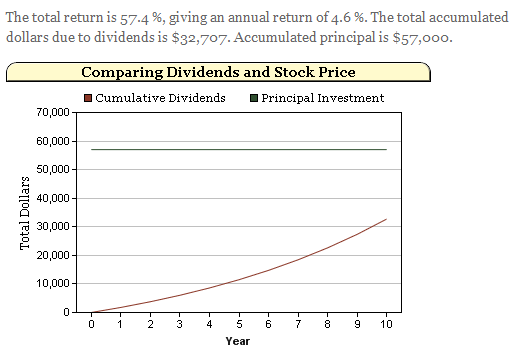The power of growing dividends over time continues to be underestimated by many investors. Many are concerned with another decade of slow growth and low to negative equity returns. However, one way to prepare for another decade of slow economic growth is to invest in high dividend yield stocks that have shown they can weather tough economic times and even increase their dividends while it happens.
One such company is Automatic Data Processing, Inc. (ADP). With a dividend yield of 3.1% and a history of increasing dividends over time, ADP is one of my favorite dividend paying stocks.
ADP Profile*:
Automatic Data Processing, Inc. provides business outsourcing solutions. The company operates in three segments: Employer Services, Professional Employer Organization (PEO) Services, and Dealer Services. The Employer Services segment offers a range of human resource (HR) information, payroll processing, time and labor management, and tax and benefits administration solutions and services, including traditional and Web-based outsourcing solutions to employers in the United States, Canada, Europe, South America, Australia, and Asia. Its solutions assist employers in the staffing, management, payment, and retention of their employees.
*Profile taken from Yahoo Finance.
| ADP: |
| Div Yield | 1 Yr Div
Growth Rate | Annualized 5 Yr Div
Growth Rate |
| 3.1% | 9.7% | 14.3% |
| Payout Ratio | Last Year in Which
Div Did Not Increase |
| 56.0% | Never (started paying
dividends in 1983) |
ADP has a solid history of growing dividends over time. The company has been paying dividends since 1983 and they have never failed to increase their dividend in any year. The growth rate of the dividend over the past 5 years has also been solid at almost 15%, although it has slowed to 9.7% in the last year. Also, ADP has a relatively low payout ratio, which means there is still room for the dividend to grow even if they hit an earnings slump.
It is not necessarily obvious how investors will fare if they hold onto ADP for the next 10 years, receiving not only the dividend, but a growing dividend over time. It’s important to analyze scenarios for such a company where we look at the dividend yield and growing dividends. I ran the following scenario on our publicly available calculator called Total Returns- Dividends Vs. Price Appreciation. If we buy 1,000 shares today, apply the 1 year growth rate of 9.7% over the next 10 years, reinvest dividends, and assume the price of the stock does not change, we get the following:
| Inputs: |
| Investment | Dividend Yield | Growth of
Dividend (Annual) |
| $57,000 | 3.10% | 9.7% |
| Outputs: |
| Total Return | Annual Return | FV Dividends | FV Investment |
| 57% | 4.6% | $32,707 | $57,000 |

An annual return of 4.6% when the stock price hasn’t moved is definitely a victory. I also included the future value of the dividend income stream compared to the future value of the initial investment. The dividends accumulated to more than $32,000 over the 10 year period. Looked at another way, the price of this stock could fall by more than 50% during this period and the investor would still break even. Now let’s take a look at what happens over 20 years using a more conservative dividend growth figure of 6%:
| Total Return | Annual Return | FV Dividends | FV Investment |
| 164% | 5.0% | $93,354 | $57,000 |
The annual return jumps to 5% even with no growth in the stock price. Again, the key here is the growing dividend payments over time. Also notice that the total dollar value of the dividend payments is nearly double the value of the initial investment. That is the beauty of high dividend paying stocks over time. The initial investment becomes less and less important.
Scenarios such as the ones I’ve run here can help investors understand the power of dividends over time, especially when those dividends are growing.